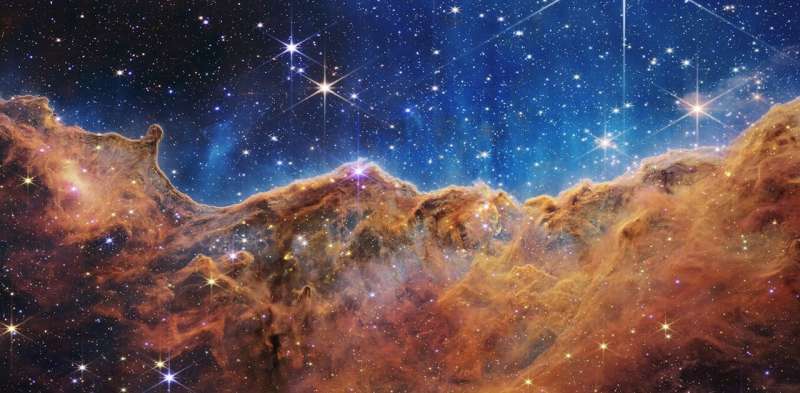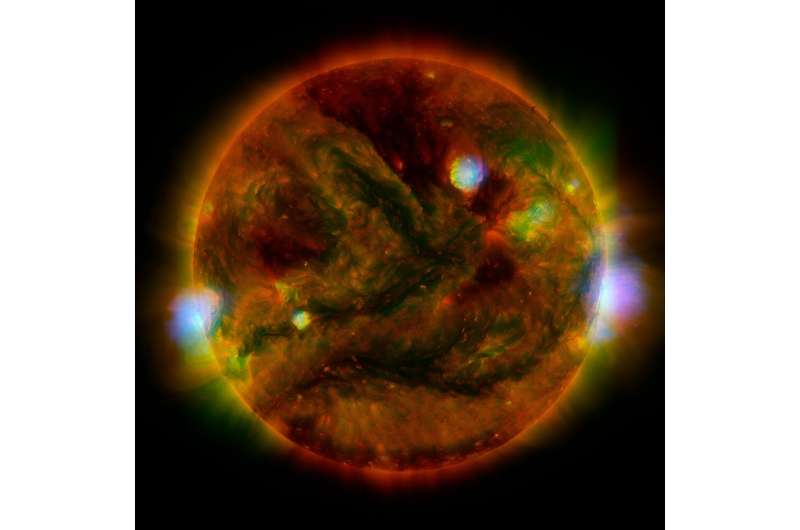This article has been reviewed according to Science X's editorial process and policies. Editors have highlighted the following attributes while ensuring the content's credibility:
fact-checked
trusted source
written by researcher(s)
proofread
The sun was born when a dense gas cloud collapsed 4.6 billion years ago

While the upcoming total solar eclipse is a special moment to reflect on our place in the universe, scientists have been studying the birth of the sun and the formation of our solar system for a long time.
Our solar system today is mainly composed of a central star—the sun—along with an inner solar system with rocky planets, and an outer solar system with gas and ice giant planets. However, it hasn't always been that way.
How was the sun formed?
Our solar system formed from the gravitational collapse of a "dense" giant molecular cloud of gas and dust, composed mainly of hydrogen, a bit of helium, and about one percent of heavier elements. After the cloud collapsed, the majority of the mass concentrated onto the center, creating our sun.
The star continued to contract until it reached its final size and density. Hydrogen fusion ignited the sun's core, causing the star to emit light and heat.
Around the sun, the leftovers —about 0.5 to one percent of the mass of the sun—created a protoplanetary disk, where planets subsequently formed.
Protoplanetary disks in the process of making planets are not just theory—they have actually been observed, such as the disk around HL Tauri, a young star with rings and gaps that are likely signs of forming planets.
We have a pretty good idea of when that collapse took place in our solar system because we can analyze the first (or oldest) solids that condensed out from the protoplanetary disk gas. This detailed analysis is only possible in our solar system, since we cannot directly collect material from other solar systems.
These solid fragments, called calcium-aluminum rich inclusions (CAIs), have been found in some of the oldest meteorites, and age-dated to 4,567.3 million years. This is when our solar system came into being, and provides the age for the birth of our sun.
Element factories
Very dense molecular clouds can collapse due to their own gravity. However, the collapse of our protosolar nebula was likely triggered by the perturbation from the passing shock wave of an exploding massive star, called a supernova. This shock wave compressed enough of the molecular cloud to start collapsing it, and form a central star and a planetary disk around it.

The evidence for this hypothesis is found in the isotope composition of some chemical elements in pre-solar grains. Pre-solar grains are tiny silicon-carbide minerals (under a micrometer in size), and can be found in parts per million quantities in some meteorites. These pre-solar grains have isotope compositions that cannot be explained by chemical or physical processes occurring in our solar system, and are better explained by these grains forming elsewhere.
The isotope composition of pre-solar grains implies that, after the supernova, these grains traveled into space, and they got trapped into our molecular cloud, which then collapsed, keeping those grains inside the meteorites that we study today.
How much older is the sun than the Earth?
The age of 4,567 million years found for the CAIs is often used as the age of the Earth. However, after the formation of CAIs, it likely took tens to a few hundreds of millions of years for Earth to form. Although we have determined the age of our solar system very precisely, debates still persist regarding the age of our own planet Earth.
The challenge comes from the fact that the Earth is an active planet, and is very efficient at recycling and reworking its oldest rocks, resetting their geochronological information.
More than 98 percent of the proto-Earth's mass might have been already melded together by the time a giant impact hit the proto-Earth. That giant impact added the remaining two percent to Earth, and also led to the formation of our moon.
The giant impact, occurring somewhere between 70 to 120 million years after the CAIs formation, could provide the best determination for the age of the Earth. Independent age estimates can also be obtained from estimating the timing of Earth's magma ocean solidification, a consequence of the moon-forming giant impact.
Studies attempting to determine the timing of magma ocean solidification provide ages between 100 and 150 million years after the birth of the sun.
The upcoming total solar eclipse is an opportunity for everyone to appreciate the wonders of our solar system, which took about 4.6 billion years to evolve.
It is truly a cosmic coincidence that total solar eclipses can be seen on Earth: the sun happens to be about 400 times larger than the moon, which is 400 times closer than the sun.
If you were on Mars or Venus, you would not be so lucky as to witness this phenomenon!
Johanna Teske of the Carnegie Institution for Science contributed to writing this article. She is a staff scientist, and researches the compositions of exoplanets.
Provided by The Conversation
This article is republished from The Conversation under a Creative Commons license. Read the original article.![]()





















